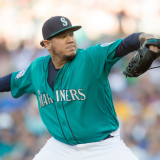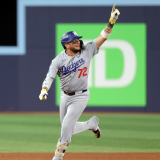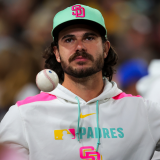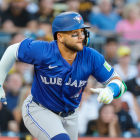Prospect Watch: National League prospects of the year for each team from the 2023 MLB season
The minor-league season is nearing its end, so let's highlight some of the best-performing prospects of the year

Minor League Baseball's season is coming to a close. That means it's time for us to highlight each system's Prospect of the Year.
We'll be upfront that this is a subjective exercise. There's almost always more than one compelling candidate in an organization, and there's no magic formula for determining which of those should earn the nod. (Even if there were such a formula, you'd probably take exception to a few of its outputs.)
In some cases, we've chosen players who double as top prospects, even if their performance was a little below some of their organizational mates; in other cases, we've opted for a top statistical performer, no matter their cachet. Do note that we've excluded players who have since appeared in the majors.
Now, with all the fine print out of the way, let's get to it.
| SS Jordan Lawlar: It's fair to write that Lawlar, the sixth pick in the 2021 draft, had a dismal May, posting a .590 OPS and striking out 15 more times than he walked in 93 plate appearances. He's otherwise had an excellent season, twice putting up full-month OPS over .900 en route to a Triple-A promotion. Lawlar, long compared to Bobby Witt Jr., has a chance for four plus or better tools at maturation and should make his big-league debut early next season. | |
| SS Ignacio Alvarez: Alvarez has had a well-above-average slash line in the South Atlantic League despite being more than two years younger than his competition. He's shown a high-quality feel for both making contact and controlling the zone, and there's a chance he provides average or better power production down the road -- that last part could prove to be crucial if he has to slide off the shortstop position. | |
| RHP Cade Horton: Horton pitched at three levels this season, including most recently at Double-A. The story has been the same at each step, as he's shown impressive bat-missing ability thanks to a power arsenal. The Cubs took Horton seventh in the 2022 draft on the basis of a strong finish to his collegiate career. He could start repaying their faith in him at the big-league level as soon as next spring. | |
| RHP Connor Phillips: We have a simple rule of thumb. You're probably getting the honor here if you're a starting pitcher who struck out more than 35% of the batters you faced in the upper minors. Phillips, originally acquired as part of the Jesse Winker trade with the Mariners, has a big-time fastball and two quality breaking balls. If he can improve his command, he has a chance to be a very interesting big-league starter, and soon. | |
| C Hunter Goodman: Goodman's carrying tool is his prodigious power, and he made the most of it this season. In 91 games at the Double-A level, he launched 25 home runs and recorded 24 doubles. The rest of Goodman's game leaves something to be desired, as he's a below-average defender and his approach is likely to be exploited in the majors. Still, he's continued to serve as a one-man home-run derby since being promoted to Triple-A. | |
| C Thayron Liranzo: As established in the introduction, we reserve the right to take creative liberties with some of these selections. Liranzo is one such example. There are better prospects in the Dodgers system and there were arguably better seasons, but we take note anytime a 20-year-old switch-hitting catcher launches 20 home runs in 78 games. While Liranzo does have plenty of hit-tool and defense-related questions to answer, we think it's safe to keep his name in mind. | |
| 1B Troy Johnston: Johnston isn't a great prospect in the traditional sense. He has, however, enjoyed a tremendous season in the upper minors, including an 83-game stint at Double-A that saw him record 18 home runs and 16 stolen bases. That's enough to earn Johnston the nod in a weak system. | |
| 3B Tyler Black: A first-round pick in 2021, Black had a massive season at Double-A ahead of being promoted to Triple-A. In 84 games, he posted a .925 OPS to go with 14 home runs (and 24 additional extra-base hits) as well as 47 stolen bases. Since being bumped up a level, he's walked more than he's struck out. Black should factor into the Brewers lineup sometime next season. | |
| SS/CF Jett Williams: We've been fans of Williams even before the Mets chose him 14th overall in 2022. He's enjoyed a terrific first professional season by showing off his well-above-average speed, contact chops, and even surprising pop for someone listed at 5-foot-6. The Mets, by the way, have wisely continued to cross train him between shortstop and center, giving them more optionality in case they decide he's a better fit on the grass. | |
| OF Justin Crawford: The 17th pick in the 2022 draft (and the son of former All-Star outfielder Carl), Crawford hit .344/.399/.478 with 40 stolen bases in 69 games in the Florida State League before being promoted up the ladder. Those marks are particularly impressive given his average launch angle was negative-9.5 degrees. We're not sure if that'll work as he climbs the ranks (it certainly won't help him tap into his power potential), but it's hard to argue with his results to date. | |
| MIF Termarr Johnson: There's no denying Johnson had a successful stint in the Florida State League, hitting for an .868 OPS in an environment where the average player was two years older and the average OPS was .720. We're still weirded out by how quickly Johnson's skill set has morphed from hit-tool driven to more power-led. Oh well. It's worked for him so far. | |
| C Ethan Salas: Salas' introduction to High-A hasn't gone well so far. That's of no bother to us. He locked this up once he proved he could hold his own as a 17-year-old playing in Low-A. | |
| MIF Diego Velasquez: Velasquez doesn't possess the sexiest skill set in the Giants system, but he's a switch-hitting middle infielder who had a well-above-average offensive season as a 19-year-old in A-ball. He showed good contact chops and (as of this writing) he had homered seven times after launching just one long ball previously in his professional career. | |
| INF Thomas Saggese: The Cardinals acquired Saggese from the Rangers as part of the Jordan Montgomery trade. He's enjoyed a phenomenal season no matter who employed him, thoroughly conquering Double-A pitching. Saggese has overachieved modest tools throughout his professional career, and he's a particular favorite of analytical types within the game. He should debut next season. | |
| OF James Wood: Brady House would've earned the designation here if not for Wood, who the Nationals obtained as part of the Juan Soto trade. Wood's strikeout rate is on the gloomy side of 30% since being promoted to Double-A, but he's had a highly productive year anyway thanks to his power, discipline, and athleticism. He's one of the top prospects in the sport, and he should make his big-league debut sometime before next summer. | |

































